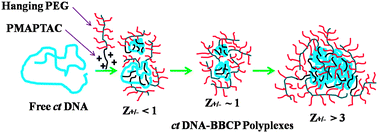Interaction between calf thymus DNA and cationic bottle-brush copolymers: equilibrium and stopped-flow kinetic studies†
Abstract
Interaction studies between a set of poly(ethylene glycol) (PEG) based cationic bottle-brush block copolymers (BBCPs) and calf thymus DNA (ctDNA) were carried out using steady state fluorescence spectroscopy, UV melting experiments and dynamic light scattering measurements. Results suggested that these cationic block copolymers could effectively bind with negatively charged DNA. Although electrostatic interaction is believed to be the predominant contributing factor in the overall binding process, hydrophobic interactions between the PEG chains and the DNA base pairs affected the binding process to some extent. Cationic block copolymers with higher PEG content were found to bind more efficiently with DNA. DLS studies revealed the details of the compaction process of elongated DNA chains into a globular structure in the presence of cationic block copolymers. Further, the kinetics of the DNA–cationic BBCP binding process was monitored via the stopped-flow fluorescence technique. In general, a two-step mechanistic pathway was observed in the case of all the cationic BBCP–DNA binding processes and the relative rate constants (k1′and k2′) were found to increase with the copolymer concentration. The first step corresponded to a fast electrostatic binding between the cationic BBCP and the anionic ctDNA, while the slow second step indicated a conformational change of the DNA polyplex that led to DNA compaction. In addition to the polymer–DNA charge ratios, the PEG content in the cationic BBCPs was found to have a significant effect on the kinetics of the ctDNA–BBCP polyplex formation.


 Please wait while we load your content...
Please wait while we load your content...